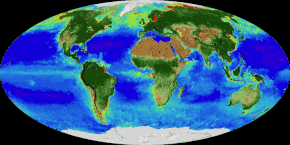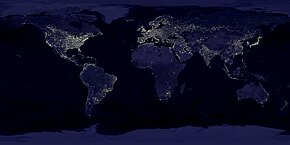EARTH 4
Life on Earth
Main articles: Biosphere and History of life An animation of the changing density of productive vegetation on land (low in brown; heavy in dark green) and phytoplankton at the ocean surface (low in purple; high in yellow)
An animation of the changing density of productive vegetation on land (low in brown; heavy in dark green) and phytoplankton at the ocean surface (low in purple; high in yellow)
Earth is the only known place that has ever been habitable for life. Earth's life developed in Earth's early bodies of water some hundred million years after Earth formed.
Earth's life has been shaping and inhabiting many particular ecosystems on Earth and has eventually expanded globally forming an overarching biosphere.[239] Therefore, life has impacted Earth, significantly altering Earth's atmosphere and surface over long periods of time, causing changes like the Great Oxidation Event.[240]
Earth's life has over time greatly diversified, allowing the biosphere to have different biomes, which are inhabited by comparatively similar plants and animals.[241] The different biomes developed at distinct elevations or water depths, planetary temperature latitudes and on land also with different humidity. Earth's species diversity and biomass reaches a peak in shallow waters and with forests, particularly in equatorial, warm and humid conditions. While freezing polar regions and high altitudes, or extremely arid areas are relatively barren of plant and animal life.[242]
Earth provides liquid water—an environment where complex organic molecules can assemble and interact, and sufficient energy to sustain a metabolism.[243] Plants and other organisms take up nutrients from water, soils and the atmosphere. These nutrients are constantly recycled between different species.[244]
Extreme weather, such as tropical cyclones (including hurricanes and typhoons), occurs over most of Earth's surface and has a large impact on life in those areas. From 1980 to 2000, these events caused an average of 11,800 human deaths per year.[245] Many places are subject to earthquakes, landslides, tsunamis, volcanic eruptions, tornadoes, blizzards, floods, droughts, wildfires, and other calamities and disasters.[246] Human impact is felt in many areas due to pollution of the air and water, acid rain, loss of vegetation (overgrazing, deforestation, desertification), loss of wildlife, species extinction, soil degradation, soil depletion and erosion.[247] Human activities release greenhouse gases into the atmosphere which cause global warming.[248] This is driving changes such as the melting of glaciers and ice sheets, a global rise in average sea levels, increased risk of drought and wildfires, and migration of species to colder areas.[249]
Human geography
Main article: Human geography
See also: World A composite image of artificial light emissions at night on a map of Earth
A composite image of artificial light emissions at night on a map of Earth
Originating from earlier primates in Eastern Africa 300,000 years ago humans have since been migrating and with the advent of agriculture in the 10th millennium BC increasingly settling Earth's land.[250] In the 20th century Antarctica had been the last continent to see a first and until today limited human presence.
Human population has since the 19th century grown exponentially to seven billion in the early 2010s,[251] and is projected to peak at around ten billion in the second half of the 21st century.[252] Most of the growth is expected to take place in sub-Saharan Africa.[252]
Distribution and density of human population varies greatly around the world with the majority living in south to eastern Asia and 90% inhabiting only the Northern Hemisphere of Earth,[253] partly due to the hemispherical predominance of the world's land mass, with 68% of the world's land mass being in the Northern Hemisphere.[254] Furthermore, since the 19th century humans have increasingly converged into urban areas with the majority living in urban areas by the 21st century.[255]
Beyond Earth's surface humans have lived on a temporary basis, with only special purpose deep underground and underwater presence, and a few space stations. Human population virtually completely remains on Earth's surface, fully depending on Earth and the environment it sustains. Since the second half of the 20th century, some hundreds of humans have temporarily stayed beyond Earth, a tiny fraction of whom have reached another celestial body, the Moon.[256][257]
Earth has been subject to extensive human settlement, and humans have developed diverse societies and cultures. Most of Earth's land has been territorially claimed since the 19th century by sovereign states (countries) separated by political borders, and 205 such states exist today,[258] with only parts of Antarctica and a few small regions remaining unclaimed.[259] Most of these states together form the United Nations, the leading worldwide intergovernmental organization,[260] which extends human governance over the ocean and Antarctica, and therefore all of Earth.
Natural resources and land use
Main articles: Natural resource and Land use Earth's land use for human agriculture
Earth's land use for human agriculture
Earth has resources that have been exploited by humans.[261] Those termed non-renewable resources, such as fossil fuels, are only replenished over geological timescales.[262] Large deposits of fossil fuels are obtained from Earth's crust, consisting of coal, petroleum, and natural gas.[263] These deposits are used by humans both for energy production and as feedstock for chemical production.[264] Mineral ore bodies have also been formed within the crust through a process of ore genesis, resulting from actions of magmatism, erosion, and plate tectonics.[265] These metals and other elements are extracted by mining, a process which often brings environmental and health damage.[266]
Earth's biosphere produces many useful biological products for humans, including food, wood, pharmaceuticals, oxygen, and the recycling of organic waste. The land-based ecosystem depends upon topsoil and fresh water, and the oceanic ecosystem depends on dissolved nutrients washed down from the land.[267] In 2019, 39 million km2 (15 million sq mi) of Earth's land surface consisted of forest and woodlands, 12 million km2 (4.6 million sq mi) was shrub and grassland, 40 million km2 (15 million sq mi) were used for animal feed production and grazing, and 11 million km2 (4.2 million sq mi) were cultivated as croplands.[268] Of the 12–14% of ice-free land that is used for croplands, 2 percentage points were irrigated in 2015.[269] Humans use building materials to construct shelters.[270]
Humans and the environment
Main articles: Human impact on the environment and Climate change Change in average surface air temperature and drivers for that change. Human activity has caused increased temperatures, with natural forces adding some variability.[271]
Change in average surface air temperature and drivers for that change. Human activity has caused increased temperatures, with natural forces adding some variability.[271]
Human activities have impacted Earth's environments. Through activities such as the burning of fossil fuels, humans have been increasing the amount of greenhouse gases in the atmosphere, altering Earth's energy budget and climate.[248][272] It is estimated that global temperatures in the year 2020 were 1.2 °C (2.2 °F) warmer than the preindustrial baseline.[273] This increase in temperature, known as global warming, has contributed to the melting of glaciers, rising sea levels, increased risk of drought and wildfires, and migration of species to colder areas.[249]
The concept of planetary boundaries was introduced to quantify humanity's impact on Earth. Of the nine identified boundaries, five have been crossed: Biosphere integrity, climate change, chemical pollution, destruction of wild habitats and the nitrogen cycle are thought to have passed the safe threshold.[274][275] As of 2018, no country meets the basic needs of its population without transgressing planetary boundaries. It is thought possible to provide all basic physical needs globally within sustainable levels of resource use.[276]
Cultural and historical viewpoint
Main articles: Earth in culture and Earth symbol Tracy Caldwell Dyson, a NASA astronaut, observing Earth from the Cupola module at the International Space Station on 11 September 2010
Tracy Caldwell Dyson, a NASA astronaut, observing Earth from the Cupola module at the International Space Station on 11 September 2010
Human cultures have developed many views of the planet.[277] The standard astronomical symbols of Earth are a quartered circle,  ,[278] representing the four corners of the world, and a globus cruciger,
,[278] representing the four corners of the world, and a globus cruciger,  . Earth is sometimes personified as a deity. In many cultures it is a mother goddess that is also the primary fertility deity.[279] Creation myths in many religions involve the creation of Earth by a supernatural deity or deities.[279] The Gaia hypothesis, developed in the mid-20th century, compared Earth's environments and life as a single self-regulating organism leading to broad stabilization of the conditions of habitability.[280][281][282]
. Earth is sometimes personified as a deity. In many cultures it is a mother goddess that is also the primary fertility deity.[279] Creation myths in many religions involve the creation of Earth by a supernatural deity or deities.[279] The Gaia hypothesis, developed in the mid-20th century, compared Earth's environments and life as a single self-regulating organism leading to broad stabilization of the conditions of habitability.[280][281][282]
Images of Earth taken from space, particularly during the Apollo program, have been credited with altering the way that people viewed the planet that they lived on, called the overview effect, emphasizing its beauty, uniqueness and apparent fragility.[283][284] In particular, this caused a realization of the scope of effects from human activity on Earth's environment. Enabled by science, particularly Earth observation,[285] humans have started to take action on environmental issues globally,[286] acknowledging the impact of humans and the interconnectedness of Earth's environments.
Scientific investigation has resulted in several culturally transformative shifts in people's view of the planet. Initial belief in a flat Earth was gradually displaced in Ancient Greece by the idea of a spherical Earth, which was attributed to both the philosophers Pythagoras and Parmenides.[287][288] Earth was generally believed to be the center of the universe until the 16th century, when scientists first concluded that it was a moving object, one of the planets of the Solar System.[289]
It was only during the 19th century that geologists realized Earth's age was at least many millions of years.[290] Lord Kelvin used thermodynamics to estimate the age of Earth to be between 20 million and 400 million years in 1864, sparking a vigorous debate on the subject; it was only when radioactivity and radioactive dating were discovered in the late 19th and early 20th centuries that a reliable mechanism for determining Earth's age was established, proving the planet to be billions of years old.[291][292]
See also
- Celestial sphere
- Earth phase
- Earth science
- Extremes on Earth
- List of Solar System extremes
- Outline of Earth
- Table of physical properties of planets in the Solar System
- Timeline of the far future
Notes
- ^ All astronomical quantities vary, both secularly and periodically. The quantities given are the values at the instant J2000.0 of the secular variation, ignoring all periodic variations.
- ^ aphelion = a × (1 + e); perihelion = a × (1 – e), where a is the semi-major axis and e is the eccentricity. The difference between Earth's perihelion and aphelion is 5 million kilometers.—Wilkinson, John (2009). Probing the New Solar System. CSIRO Publishing. p. 144. ISBN 978-0-643-09949-4.
- ^ Earth's circumference is almost exactly 40,000 km because the meter was calibrated on this measurement—more specifically, 1/10-millionth of the distance between the poles and the equator.
- ^ Due to natural fluctuations, ambiguities surrounding ice shelves, and mapping conventions for vertical datums, exact values for land and ocean coverage are not meaningful. Based on data from the Vector Map and Global Landcover Archived 26 March 2015 at the Wayback Machine datasets, extreme values for coverage of lakes and streams are 0.6% and 1.0% of Earth's surface. The ice sheets of Antarctica and Greenland are counted as land, even though much of the rock that supports them lies below sea level.
- ^ If Earth were shrunk to the size of a billiard ball, some areas of Earth such as large mountain ranges and oceanic trenches would feel like tiny imperfections, whereas much of the planet, including the Great Plains and the abyssal plains, would feel smoother.[89]
- ^




















































